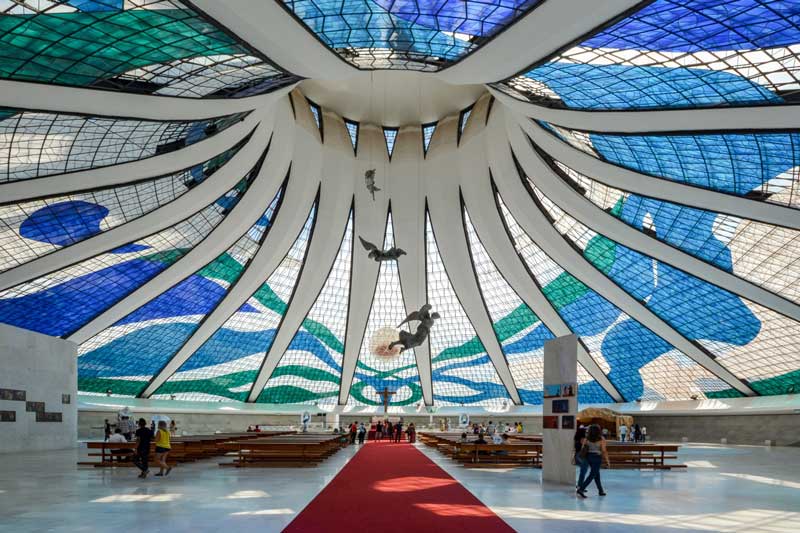
Designed by the reputed Brazilian architect Oscar Niemeyer and projected by the structural engineer Joaquim Cardozo, the Cathedral of Brasilia resembles almost a crown-like hyperboloid structure, held by 16 concrete columns, each weighing 90 tons, and forming a thorn crown. With its striking shape and the gorgeous stained glass ceiling in shades of blue, green, white, and brown, the fascinating Roman Catholic Cathedral serves as the seat of the Archdiocese of Brasilia.
Officially named the Metropolitan Cathedral of Our Lady of Aparecida, it was dedicated to the Blessed Virgin Mary as Our Lady of Aparecida, proclaimed by the Church as Queen and Patroness of Brazil.

The cornerstone for the Cathedral of Brasilia was laid in September 1958, and the mainframe structure was completed within two years, in April 1960, with only the roof structure visible above the ground. Unfortunately, further construction was stalled as the Presidential term of Juscelino Kubitschek ended in 1961. Although he intended to create a state-funded cathedral open to all faiths, the incomplete building of the cathedral was handed over to the Catholic Church for completion.
Finally, the Cathedral was consecrated on 12 October 1968, without a roof, and was officially opened by Cardinal D. Eugenio Salles on 31 May 1970.

Four bronze sculptures, each about 9.8 feet (3 m) tall, representing the four Evangelists, namely Matthew, Luke, Mark, and John, stand near the entrance as if guarding the cathedral. The 66 feet (20 m) tall bell tower, containing four large bells, that also stands outside the cathedral was donated by Spain. There is also a single pillar at the entrance, containing passages from the life of Mother Mary, painted by Athos. While entering the cathedral through a dark entrance, the visitors pass under a pool, 39 feet (12 m) wide and 16 inches (40 cm) deep that surrounds the cathedral and helps to keep it cool.
The oval baptistery, with its walls covered with painted ceramic tiles, is located to the left of the entrance and can be entered either through the cathedral or by negotiating a spiral staircase from the entrance plaza.

To enter the cathedral, the visitors are required to proceed through a dark tunnel that ends in a bright space, under the cover of the glass roof. The roof is created with sixteen pieces of fiberglass, each measuring 33 feet (10 m) wide at the base and 98 feet (30 m) long, inserted between the concrete pillars. The lower part of the roof, measuring 22,000 sq feet (2,000 sq m), made of stained glass work, and suspended under the outer cover, was created in 1990 by Marianne Peretti.

Inside the spacious interior of the cathedral, sculptures of three angels are suspended over the nave by steel cables. While the largest among them is 13.9 feet (4.25 m) tall and weighing 300 kg, the middle one is 11 feet (3.4 m), weighing 200 kg and the shortest is 7 feet 3 inches (2.22 m) tall and weighing 100 kg. They are covered by the stained glass ceiling in colourful shades, composed of a series of 98 feet high triangles. Apart from the decorative items, one of the notable units of the Cathedral of Brasilia includes its altar, donated by Pope Paul VI, and the other is the image of the patron saint Our Lady of Aparecida, a replica of the original in Sao Paulo. There is a small chapel under the main altar, which is accessible by steps from either side of the altar or from behind it.

Unfortunately, as the deterioration of the building materials were compromising the integrity of the building, the first renovation project was undertaken in 1987, only after seventeen years of its completion. During that time, its clear glass with stained glass by Marianne Peretti was fully replaced, introducing a better system to affix the glass to the metal structure. The internal stained glass and the external glass were replaced again between 2009 and 2012 with a better quality of glass, while maintaining the original designs by Marianne Peseta.
Nevertheless, the Cathedral of Brasilia, dominated by 16 curved concrete columns, meeting briefly before branching back outwards and upwards to give the structure its shape resembling a hourglass, is definitely an impressive sight. Rising up to a height of about 131 feet, it bears some resemblance to a white crown, or a crown of thorns.